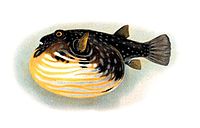
Photo from wikipedia
Objectives of this study were to evaluate apparent total tract nutrient digestibility and purine derivative (PD) excretion in dairy heifers limit-fed diets containing wet brewer's grains (WBG) treated with salt.… Click to show full abstract
Objectives of this study were to evaluate apparent total tract nutrient digestibility and purine derivative (PD) excretion in dairy heifers limit-fed diets containing wet brewer's grains (WBG) treated with salt. A 12-wk replicated 4 × 4 Latin square was conducted using 8 Holstein heifers of 224.5 ± 19.4 d of age, and body weight (BW) of 219.2 ± 28.1 kg (mean ± SD). Fresh WBG were treated with 0%, 0.8%, 1.6%, and 2.4% salt and stored for 4 d before being fed. Salt was added either to the WBG or separately to equalize the amount of salt in the diet. The diet contained 9% grass silage, 47% corn silage, 19% corn meal, 17.6% WBG and salt, 2% soybean meal, and 3% mineral mix. Diets were formulated to be limit-fed at 2.15% of BW, provide 14% crude protein (CP) and 2.27 Mcal metabolizable energy (ME)/kg of dry matter (DM). Heifers were adapted to diets for 14 d followed by a 7-d collection period. Dry matter intake (DMI) was recorded daily during the collection week while BW was recorded once a week. Urine and fecal samples were collected during the last 4 d of the collection period. Acid insoluble ash was used as an internal marker to determine apparent nutrient digestibility. Weight loss of WBG during storage was determined from days 1 to 11 and initial and final yeast and mold counts were determined. Final yeast counts were similar among treatments while final mold counts tended to be lesser (P = 0.07) for the 0.8% and 1.6% salt treatments. Urinary volume was similar among treatments while allantoin (P = 0.14), and uric acid (P < 0.01) and total PD excretion tended to increase (P = 0.13) quadratically. DMI was varied by treatment (linear, quadratic, and cubic effects P < 0.01). Heifers fed the 0.8% treatment had the least DMI. Nonfiber carbohydrate (NFC) digestibility linearly decreased (P < 0.04) as salt increased. Digestibilities of DM, and organic matter (OM), tended to decrease (P < 0.10) with increasing levels of salt added to WBG. Fat digestibility was quadratic with the greatest value for the 1.6% treatment. Treating WBG with salt reduced its deterioration based on lesser mold counts for the 0.8% and 1.6% treatments. These treatments had resulted in greater fat digestibility and tended to have increased PD excretion suggesting improved microbial protein synthesis.
Journal Title: Journal of animal science
Year Published: 2021
Link to full text (if available)
Share on Social Media: Sign Up to like & get
recommendations!